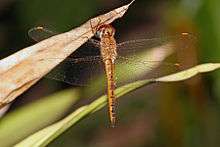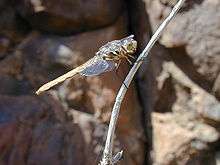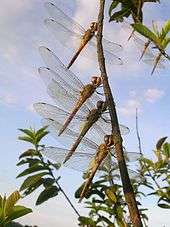Pantala flavescens
| Pantala flavescens | |
|---|---|
 | |
| Dar es Salaam, Tanzania | |
| | |
| Grand Cayman, Cayman Islands | |
| Scientific classification | |
| Kingdom: | Animalia |
| Phylum: | Arthropoda |
| Class: | Insecta |
| Order: | Odonata |
| Suborder: | Anisoptera |
| Family: | Libellulidae |
| Genus: | Pantala |
| Species: | P. flavescens |
| Binomial name | |
| Pantala flavescens (Fabricius, 1798) | |
 | |
| Distribution of Pantala flavescens | |
Pantala flavescens, the globe skimmer or wandering glider, is a wide-ranging dragonfly of the family Libellulidae. This species and Pantala hymenaea, the "spot-winged glider", are the only members of the genus Pantala from the subfamily Pantalinae. It was first described by Fabricius in 1798.[1] It is considered to be the most widespread dragonfly on the planet.[2]
Characteristics
Structure of the adult

The dragonfly is up to 4.5 cm long,[3] reaching wing spans between 7.2 cm and 8.4 cm.[4] The front side of the head is yellowish to reddish. The thorax is usually yellow to golden colored with a dark line and hairy. There were also specimens with a brown or olive thorax. The abdomen has a similar color as the thorax.[4][5]
The wings are clear and very broad at the base. There, too, there are some specimens with olive, brown and yellow wings. On Easter Island there are wandering gliders with black wings.[4][5]
The pterostigma turns yellowish. The transparent wings may turn a yellowish shade towards the tip. The chestnut-red eyes take up most of the head, as is usual in the large dragonflies (Anisoptera).[6]
The above colors explain the many scientific descriptions of this species under different names.
Structure of the larva
The larva is between 24 and 26 mm long. It is light green with light, brown speckles. The round eyes are sideways on the bottom of the head, the abdomen and the tail blunt.[7]
The paired side plates on the eleventh segment of the abdomen, the so-called paraproct, is smooth when seen from the side. The unpaired dorsal plate of the eleventh segment, called the epiproct, is roughly the same length as or longer than the paraproct. This distinguishes them from larvae of the genus Tramea, where the epiproct is shorter than the paraproct. Furthermore, the mouth parts (palpus) have 12–14 bristles and thus fewer than P. hymenaea which has 15–18 bristles.[8]
Dimorphism
Females show some differences compared with males. The general rule is that the wings of the male are darker than on the females. In mainland males, the length of the femur, the longest leg section, varies; they also have longer front and shorter hind wings than the females. The island representatives, however, have the front and hind wings longer than the female, and the femur is the same for both sexes. There are other differences between mainland and island specimens, particularly in terms of coloring. Island representatives are generally darker.[5]
Similar species
Pantala flavescens may be confused with the P. hymenaea, the "spot-winged glider", but this has a striking brown basal fleck in the hindwing and is generally slightly darker in color. It might be taken for a member of the genus Tramea but these usually have a distinctive stripe on their hind wings.[9]
Life cycle
Reproduction and development
_mating_W_IMG_2999.jpg)
As is usual in the Libellulidae family, there is no distinct courtship ritual. The females may pair many times, but usually only once a day.[10]
After mating, the migrant dragonflies fly in tandem, with the female ovipositing while the male remains connected. A clutch consists of about 500 to 2000 eggs. The eggs are spheroid in shape with the semi-major axis 0.5 mm and 0.4 mm at the smallest points.[11]
The larvae develop within 38 to 65 days,[12] which allows this migrant dragonfly to reproduce in temporary waters or even in swimming pools.[13] However, the larvae seem to be very sensitive to temperature.[14] The life expectancy is not known and because of their high mobility it is almost impossible to determine.
Food
The larvae of the globe skimmer, like all dragonflies, are predatory. It forages very actively and eats fairly indiscriminately all sorts of aquatic invertebrates, such as aquatic insect larvae and small shrimps (Peracarida). Even tadpoles and small fish are used for food. The imago eats mostly small insects such as mosquitoes, swarming flying ants, and termites.[7]
Flight behavior

Their flight speed is up to 5 m / s.[15] Especially in the autumn, the wandering glider flies in large swarms, using thermals to advantage. One report even speaks of a "cloud" covering 34 km2.[7] They prefer moist winds.[16] In normal flight, island populations keep to 2.5 meters above the ground and stop flying in thermal updraughts. The continental populations fly at altitudes of three to four meters, and do not stop flying even in bad weather. Those on Easter Island have adapted away from their migratory habits because to fly out to the open sea would usually mean certain death.[5]
When landing, it seeks a vertical attitude.[3] Like all large dragonflies, the wings are held out from the body at rest.
Distribution and flight

The globe skimmer, as its name suggests, has a very wide distribution area, between about the 40th parallels of latitude or within the 20 °C isotherm (areas of the world where the annual mean temperature is above 20 degrees Celsius). In Europe there are only occasional sightings of the species, with serious evidence to date mainly from the Aegean Sea and the adjacent mainland. All globe skimmer records from England or France are of extremely doubtful value and may arise from co-importation with shipments of bananas. An explanation for the scarcity in Europe of this otherwise common species is the barrier effect of the Sahara which generates unfavourable winds, such as the Sirocco,[16] whose dryness makes dragonfly passage almost impossible.[17]
Their arrival in the subtropics and tropics coincides with the Intertropical Convergence Zone.[18] More evidence of their preference for moist winds is that the dragonfly migrates to Southeast India's Tamil Nadu only after the second monsoon, which brings the rain to that region. In the rest of India, however, it arrives with the first rain-making monsoon.[16] Observations and stable isotope evidence suggests that they migrate from India or beyond to Africa across the Arabian Sea.[19][20]
It is the highest-flying dragonfly, recorded at 6,200 m in the Himalayas. It was also first dragonfly species that settled on Bikini Atoll after the nuclear tests there.[13] Furthermore, it is the only Odonata on Easter Island. These individuals seem to be a small gene pool, derived from the continental populations, which is slowly creating a new type by genetic drift. In colder areas like South Australia and Southern Canada, the species cannot overwinter and must therefore be replaced by new migrants each year.[5]
According to recent research carried out by biologists at Rutgers University-Newark this species of dragonfly is the world's longest distance traveller. Genetic evidence taken from dragonflies across the globe suggests that these small size insects are travelling vast distances to mate and are thus creating a worldwide gene pool.[21]
Naming
Common name
The English common names "wandering glider" and "globe skimmer" refer to its migratory behaviour.[3] The German name Wanderlibelle means "migrant dragonfly". In Hong Kong, its name translates as typhoon dragonfly as it arrives with or shortly before the seasonal rain.[16] The Japanese name is Usubaki-Tombo (ウスバキトンボ) which is translated as "yellow dragonfly with delicate wings." Similarly, South Korean name is '된장잠자리'(translated as "Doenjang dragonfly") because its colour is similar to Doenjang, the Korean bean paste.
Scientific name
In the scientific name Pantala flavescens, the genus name Pantala means "all wings," alluding to the big and long wings. The specific name comes from the Latin flavescens, meaning "yellowish," and refers to its distinctive golden tint.[3]
The species was first described in 1798 as Libellula flavescens by Fabricius as follows:
L. [flavescens] alis hyalinis: stigmate niveo, corpore flavescente. Habitat in India Dom. Daldorff. Statura praecedentium. Caput flavescens oculis magnis, fuscis. Thorax flavescens, immaculatus. Abdomen compressum, flavescens linea dorsali nigra. Alae albae stigmate marginali niveo.— Fabricius, Entomologia systematica emendata et aucta Supplement S. 285
The first description of this underlying holotype is in the Zoological Museum of Copenhagen University taken from a female collected from India. In following years there appeared more descriptions with different names. In 1805, Palisot de Beauvois designated a specimen from Nigeria as Libellula viridula. Around 1823 the British entomologist Dale, in an unpublished manuscript, described an allegedly Norfolk-trapped male as Libellula sparing halli,[22] It is now in the Oxford University Museum of Natural History. In 1839, the German entomologist Burmeister named a male collected in Madras as Libellula analis (now in the Zoological Collection of the University of Halle-Wittenberg) and another male from Brazil as Libellula terminalis (now in the Natural History Museum of Vienna.) In 1910, the field was cleared as Richard Anthony Muttkowski recognized that these species were all synonyms. A description made of Sympetrum tandicola (Singh) 1955 from a male collected in the Himalayas and deposited at the Zoological Survey India, Calcutta, was identified as belonging to Pantala flavescens in 1973.[1]
Classification
Pantala flavescens and Pantala hymenaea, the spot-winged glider, are the only members of the genus Pantala. This in the only genus in the subfamily Pantalinae of the family Libellulidae. P. hymenaea is restricted to the Americas.
In cladistics the genus Pantala is also placed in the subfamily Pantalinae. There is no up-to-date investigation of the subfamilies of the Libellulidae which would permit a dichotomous representation of the phylogeny. From the current state of research, the Pantalinae cannot clearly be allocated to a subfamily rather than a sister group.[23]
| Libellulidae |
| ||||||||||||||||||
| |
Protection status
The globe skimmer has NatureServe conservation status G5, meaning it is secure (common, widespread and abundant) worldwide. This status was awarded on 30 December 1985. In the United States, it has the national equivalent protection status N5. In Canada, however, it is lower with N4 meaning it is apparently secure – uncommon but not rare but with some cause for long-term concern. Even at this level, it is granted protected status in many states of the US and Canada.[24]
Postage stamps
Due to its wide distribution, the globe skimmer appears on a number of stamps.
On 29 July 1974 Wallis and Futuna published a 45 Franc with a dragonfly over a water surface with some plants showing. It has Michel catalog number 257 appearing in a set of insect motifs. On 9 November 1975 The Pitcairn Islands published a 15 Cent with a dragonfly flying ona dark blue background. Its Miche number is 154, and it also appeared in an insect collection.[25]
Tuvalu brought out a 10 Cent on 25 May 1983 which shows a globe skimmer. The lithographic illustration was designed by J E Cooter. Its Michel number is 190, and it appeared in a set of dragonflies.[26][27] The representation was limited to the dragonfly with grasses. Botswana published a six-Thebe stamp showing the front of a blue dragonfly on a green background.[28]
Wallis and Futuna published another stamp on 4 August 1998, a 36F with the dragonfly shown flying on a yellowish background. It has Michel number 736 and appeared together with other insect motifs.[29]
The latest stamp comes from 2003 and appeared in North Korea. Its value is 15 wŏn and it represents a sedentary globe skimmer on a spike.[30]
Notes
- 1 2 Henrik Steinmann (1997) (in German), World Catalogue of Odonata, Band II (Anisoptera), Berlin/New York: de Gruyter, pp. 542f, ISBN 3-11-014934-6
- ↑ James William Tutt (1997) (in German), The Entomologist's Record and Journal of Variation, London: Charles Phipps., pp. 213
- 1 2 3 4 Cynthia Berger (March 2004) (in German), Dragonflies (Wild Guides), Mechanicsburg (Pennsylvania): Stackpole Books, pp. 97, ISBN 0-8117-2971-0
- 1 2 3 Arnett H. Ross jr. (2000) (in German), American Insects. A Handbook of Insects of America North of Mexico, Boca Raton: CRC Press, pp. 128, ISBN 0-8493-0212-9
- 1 2 3 4 5 M. J. Samways, R. Osborn, M.; Osborn, R. (1998). "Divergence in a transoceanic circumtropical dragonfly on a remote island". Journal of Biogeography. 25 (5): 935–946. doi:10.1046/j.1365-2699.1998.00245.x.
- ↑ Tim Manolis, Timothy D. Manolis (April 2003). Dragonflies and Damselflies of California (California Natural History Guides (Paperback)). University of California Press. p. 40. ISBN 0-520-23567-3.
- 1 2 3 Mark Lung, Stefan Sommer. "Pantala flavescens". Retrieved 9 March 2006.
- ↑ Jerrell James Daigle (November 1992). "Florida Dragonflies (Anisoptera): A Species Key to the Aquatic Larval Stages". Technical Series. 12 (1): 23.
- ↑ J.C. Abbott. "OdonataCentral: An online resource for the Odonata of North America. Austin, Texas". odonatacentral.com. Retrieved 12 May 2006.
- ↑ Alex Córdoba-Aguilar (2006). "Sperm ejection as a possible cryptic female choice mechanism in Odonata (Insecta)". Physiological Entomology. Online. Early (2): 146. doi:10.1111/j.1365-3032.2005.00498.x.
- ↑ Kamilla Schenk, Dagmar Söndgerath (2005). "Influence of egg size differences within egg clutches on larval parameters in nine libellulid species (Odonata)". Ecological Entomology. 30 (4): 456. doi:10.1111/j.0307-6946.2005.00707.x.
- ↑ Frank Suhling; Kamilla Schenk; Tanja Padeffke; Andreas Martens (2004). "A field study of larval development in a dragonfly assemblage in African desert ponds (Odonata)". Hydrobiologia. 528: 75–85. doi:10.1007/s10750-004-3047-8.
- 1 2 Jill Silsby (2001) (in German), Dragonflies of the World, Plymouth: The National History Museum, pp. 180, ISBN 0-565-09165-4
- ↑ J. H. Hawking, B. A. Ingram (1994). "Rate of larval development of Pantala flavescens (Fabricius) at its southern limit of range in Australia. (Odonata: Libellulidae) (zit. nach Laister)". Odonatologica. 23: 63–68.
- ↑ Robert B. Srygley (March 2003). "Wind Drift Compensation in Migrating Dragonflies Pantala (Odonata: Libellulidae)". Journal of Insect Behavior. 16 (2): 217–232. doi:10.1023/A:1023915802067.
- 1 2 3 4 Philip S. Corbet (1 August 1999) (in German), Dragonflies: Behaviour and Ecology of Odonata (zit. nach Laister), Colchester: Harley Books, ISBN 0-946589-64-X
- ↑ G. Laister (2005). "Pantala flavescens auf Rhodos, mit einem Überblick über den Status der Art in Europa (Odonata: Libellulidae)". Libellula Supplement. 6: 33–40.
- ↑ Gerhard Jurzitza (1978) (in German), Unsere Libellen, Franckh, pp. 22, ISBN 3-440-04553-6
- ↑ Anderson, RC (2009). Do dragonflies migrate across the western Indian Ocean? Journal of Tropical Ecology 25: 347–348 PDF
- ↑ Hobson, K.A.; Anderson, R.C.; Soto, D.X.; Wassenaar, L.I. (2012). "Isotopic Evidence That Dragonflies (Pantala flavescens) Migrating through the Maldives Come from the Northern Indian Subcontinent.". PLoS ONE. 7 (12): e52594. doi:10.1371/journal.pone.0052594.
- ↑ "Small dragonfly found to be world's longest-distance flyer". Science Daily. Retrieved 3 March 2016.
- ↑ F.C. Fraser (1956). "A restatement of the case of Pantala flavescens (F.) (Odon., Libellulidae) as a casual visitor to Britain.". The Entomologist’s monthly Magazine. 92: 347–350.
- ↑ Mikko Haaramo. "Mikko's Phylogeny Archive Neolamellida". Retrieved 25 March 2006.
- ↑ "NatureServe Explorer: An online encyclopedia of life". NatureServe. February 2006. Retrieved 25 March 2006.
- ↑ "Libellen Briefmarken 1970–1979". Gesellschaft deutschsprachiger Odonatologen. Retrieved 24 March 2006.
- ↑ "1983 – Tuvalu Commemorative Stamps". Tuvalu Online. Brian Cannon. Retrieved 24 March 2006.
- ↑ "Libellen Briefmarken 1980–1984". Gesellschaft deutschsprachiger Odonatologen. Retrieved 24 March 2006.
- ↑ "Dragonfly Stamp of Botswana". Insects on Stamps. Retrieved 24 March 2006.
- ↑ "Libellen Briefmarken 1995–1999". Gesellschaft deutschsprachiger Odonatologen. Retrieved 24 March 2006.
- ↑ "Libellen Briefmarken 2003–2005". Gesellschaft deutschsprachiger Odonatologen. Retrieved 24 March 2006.
References
Initial descriptions
- Fabricius (in German), Entomologia systematica emendata et aucta : Supplement, pp. 285
- Beauvois (in German), Insectes recueillis en Afrique et en Amérique, pp. 69
- Burmeister (in German), Handbuch der Entomologie, Band 2, pp. 852
Secondary literature
- Arnett H. Ross jr. (2000) (in German), American Insects. A Handbook of Insects of America North of Mexico, Boca Raton: CRC Press, ISBN 0-8493-0212-9
- Cynthia Berger (March 2004) (in German), Dragonflies (Wild Guides), Mechanicsburg (Pennsylvania): Stackpole Books, pp. 97, ISBN 0-8117-2971-0
- Gerhard Jurzitza (1978) (in German), Unsere Libellen, Franckh, ISBN 3-440-04553-6
- Jill Silsby (2001) (in German), Dragonflies of the World, Plymouth: The National History Museum, ISBN 0-565-09165-4
Scientific literature and articles
- Philip S. Corbet (1999) (in German), Dragonflies: Behaviour and Ecology of Odonata, Colchester: Harley Books, ISBN 0-946589-64-X
- F. C. Fraser (1956), "A restatement of the case of Pantala flavescens (F.)(Odon., Libellulidae) as a casual visitor to Britain" (in German), The Entomologist's monthly Magazine 92: pp. 347–350, ISSN 0013-8908
- J. H. Hawking; B. A. Ingram (1994), "Rate of larval development of Pantala flavescens (Fabricius) at its southern limit of range in Australia. (Odonata: Libellulidae)" (in German), Odonatologica 23: pp. 63–68, ISSN 0375-0183
- A. Kumar (1984), "On the life history of Pantala flavescens (Fabricius) (Libellulidae: Odonata)" (in German), Annals of the Entomological Society of America 2 (1): pp. 43–50, ISSN 0013-8746
- G. Laister (2005), "Pantala flavescens auf Rhodos, mit einem Überblick über den Status der Art in Europa (Odonata: Libellulidae)" (in German), Libellula Supplement 6: pp. 33–40, ISSN 0723-6514
- M. Samways; R. Osborn (1998), "Divergence in a transoceanic circumtropical dragonfly on a remote island" (in German), Journal of Biogeography 25: pp. 935–946, ISSN 0305-0270
- Henrik Steinmann (1997) (in German), World Catalogue of Odonata, Band II (Anisoptera), Berlin/New York: de Gruyter, pp. 542f, ISBN 3-11-014934-6
- K. Van Damme; H. J. Dumont (1999), "A drought–resistant larva of Pantala flavescens (Fabricius, 1798) (Odonata: Libellulidae) in the Lencois Maranhenses, NE-Brazil" (in German), International Journal of Odonatology 2: pp. 69–76, ISSN 1388-7890
External links
| Wikimedia Commons has media related to Pantala flavescens. |
| Wikispecies has information related to: Pantala flavescens |
- "Pantala flavescens (Fabricius, 1798)". Integrated Taxonomic Information System.
- Images
- Charles Anderson discovers dragonflies that cross oceans, TEDIndia 2009
